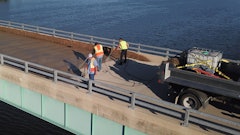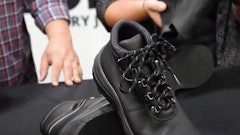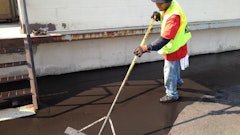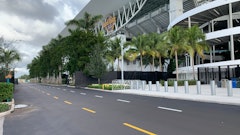
Large sealcoating jobs can often involve many challenges. It takes careful planning, communication, and a dedicated crew of employees to successfully complete a large sealcoating job. It helps to have any easy-to-work-with customer, too. For Sonnenberg Asphalt Co. Inc., Belleville, IL, all of these elements came together on a recent job that required 6,858,000 sq. ft. of sealcoat.
Sonnenberg started in 1983 as a small sealing and patching company. It has since grown to specialize in commercial asphalt paving along with a commercial and residential sealcoating operations that have grown year after year.
This particular job involved sealcoating and striping parking lots for Southern Illinois University Edwardsville on both its main and two satellite campuses. The job started on May 17, 2010 with a completion deadline of August 1, 2010. It called for two coats of 100% coal tar sealer, diluted with no more than 20% water, says Justin Mayberry, asphalt division estimator for Sonnenberg. The lots also had to be restriped. "This was by far our largest sealing project in the 27 years Sonnenberg Asphalt has been in business," Mayberry says.
The company found out about the SIUE job through a public notice from the Southern Illinois Builders Association. All companies had to be pre-qualified before submitting a bid, Mayberry adds.
Pre-planning
Once awarded the bid, Sonnenberg met with a team of reps from the university and the project engineer, Oates Associates. Although the project was being done over the summer, there would still be students and employees using the campuses during the work. The university let Sonnenberg know what lots they could work on, when, and how long they could be on those lots. Having the client dictate the working schedule actually worked in Sonnenberg's favor, Mayberry says.
But the university allowed for some flexibility in the schedule. With only one asphalt crew in the company, Sonnenberg did have other jobs going at the same time. "We talked about it at the pre-job meeting and let the university know when we wouldn't be on site due to other job commitments," Mayberry says. "We also let our new clients know we were working on this big job."
Sealer on the Job
The university job was a half hour from Sonnenberg's yard and one hour from its sealer supplier, McConnell & Associates of St. Louis, MO. "Running out of sealer in the middle of the day was a concern heading into the project but never became problem," Mayberry says. "We had good communication with our supplier." Once the job got going Sonnenberg and McConnell were able to figure out a schedule for delivering sealer that would keep the job running smoothly. McConnell delivered at least one 4,200-gal. tank of sealer per day, Mayberry says. If the lot being worked on was large, McConnell would deliver more than one tank of sealer if needed.
No sand was required for this sealcoat, but it did have to be mixed with water, which Sonnenberg did on site. A 1,500-gal.water truck in the staging area pumped 300 gallons of water into a separate 1,500-gal. Seal-Rite tank mounted on an International Flatbed Tandem truck. The water was mixed with 1,200 gallons of sealer and then the mix was transferred to the sealcoating units and applied to the parking lot.
Sealing Multiple Lots
With pre-planning complete Sonnenberg was ready to start the job. The main campus has a series of parking lots shaped like a fan along with other lots scattered across the campus, Mayberry says. In order to prevent tracking over completed work, Sonnenberg's staging area remained on one lot and was only moved at the very end so they could sealcoat the last lot.
The Sonnenberg crew varied from four to six workers per day, including company owner Kirk Sonnenberg. Two crew members were dedicated solely to prep work. They used backpack blowers to clean the smaller, confined areas on the lots. They also had a trailer attached to a S-220 Bobcat skid steer. The trailer held two Buffalo Turbine debris blowers. Pulling the blowers worked really well and allowed the prep crew to work one lot ahead of the sealcoating crew.
The sealcoating crew started by trimming the edges of the parking lot they were working on. Using a broom and squeegee, the crew sealed about a 3-ft. width from the edges of the lot. The main portion of the lots were sealed using two SealMaster SP 300 squeegee machines which Sonnenberg outfitted with custom-made 18- to 24-in. brooms on the back of the units. This allowed them to get a combination of squeegee and broom application across the whole project. The crew applied the first coat, let it dry, and then applied a second coat of sealer using the same application process.
Work started on lots for the university's main campus. After completing about 75% of the lots on the main campus, Sonnenberg moved over to the other campuses (a dental school and a secondary school campus). The crew then went back to finish the main campus lots. "In all there was a total of 60 different areas we needed to sealcoat, including some roadways but mainly parking lots," Mayberry says.
Sonnenberg subbed the striping work to B-Line Striping, E. Alton, IL. Once sealcoating was complete on a lot the striping subcontractor came in to restripe. The finished lot could then be reopened even though the entire job had not been completed yet.
The crew worked between eight to nine hours a day and sometimes was able to complete work on smaller lots in one day's time. Mayberry says the crew applied over 80,000 gallons of bulk sealer at the SIUE campuses.
Making the Deadline
In a job consisting of multiple lots in three different locations and a crew that had to work on other jobs during the same time period, it might seem that meeting a deadline is a major challenge. Sonnenberg had no problems sticking to the university's deadline, though. In fact, the Sonnenberg crew completed the job in just 29 working days, well before the deadline.

















![Screen Shot 2023 01 04 At 5 23 30 Pm[35]](https://img.forconstructionpros.com/files/base/acbm/fcp/image/2023/01/Screen_Shot_2023_01_04_at_5.23.30_PM_35_.63bc42696de27.png?auto=format%2Ccompress&fit=crop&h=135&q=70&w=240)










